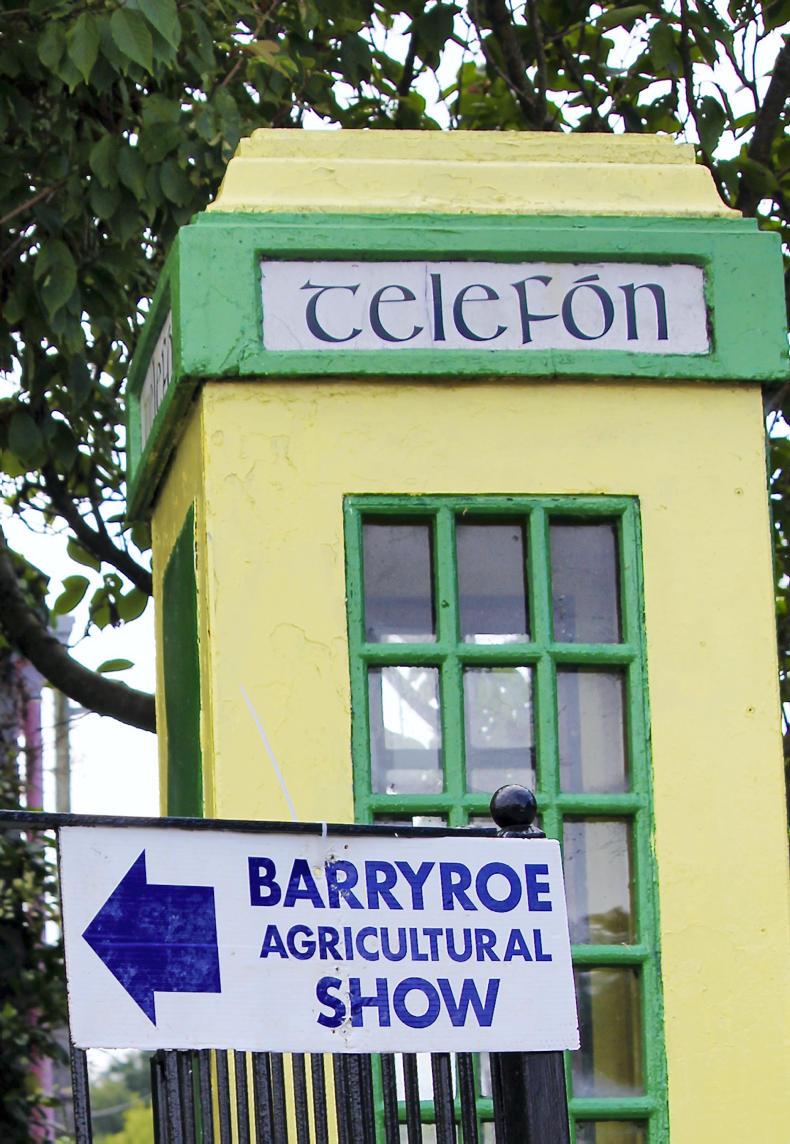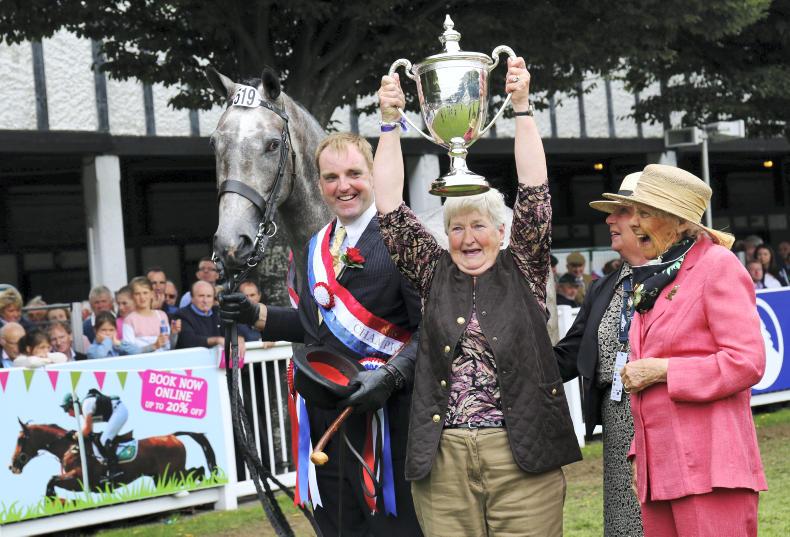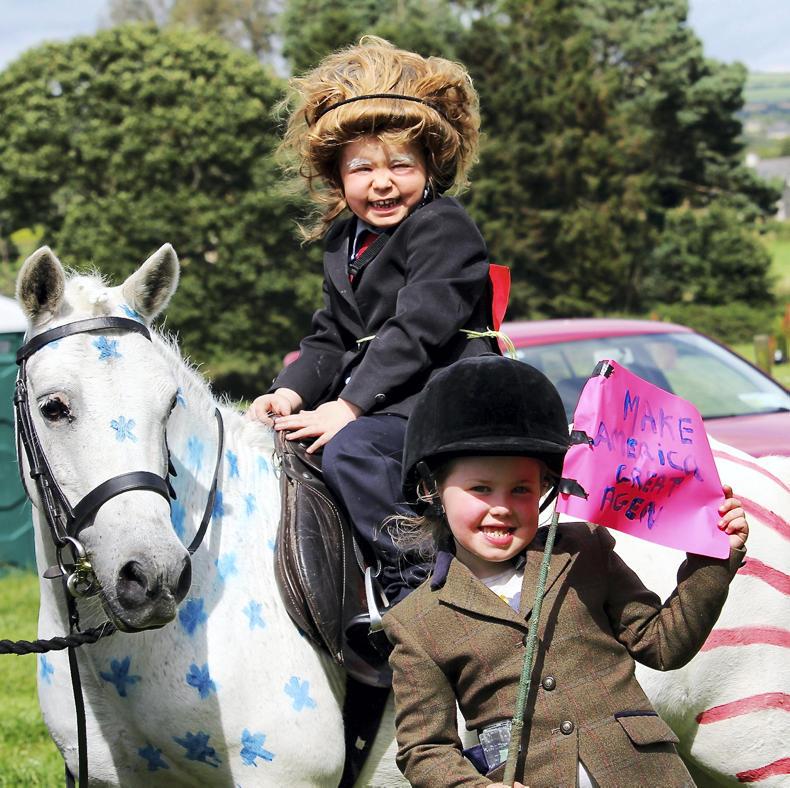1. Before the 2017 show season began, the showing and Connemara communities turned out in force in February to support a fund-raising night for young Leitrim exhibitor Colm Costello.
2. The Irish Shows Association yearbook, often referred to as the ‘exhibitors bible’, was launched in March by Junior Minister for Agriculture Andrew Doyle in Roscommon and 2017 yielded several sightings at the country’s 130-plus shows of both Doyle and his senior counterpart Michael Creed.
3. At Louisburgh Show, newly-appointed Minister for Community and Rural Affairs Michael Ring, indicated that his department would look at a financial package to support agricultural shows.
4. April was the month Irish breeding lost Colin Diamond, a producer of several All-Ireland and Dublin champions. Bred by ISA board member and standing his entire life with the McDonnell family in Nenagh, his imprint continued throughout the season, including the Newell family’s traditional foal final win at Mountbellew with a Financial Reward-Colin Diamond filly.

Finely-tuned ‘big shows’ such as Bannow & Rathangan and Charleville are in a well-earned league of their own. And then there was this pitch-perfect show which proved that even a self-proclaimed ‘small’ show can be planned to the nth degree. Their pride at hosting their first All Ireland equine final was written all over the faces of a hard-working committee and the stories told by a range of local characters was a reminder that agricultural shows aren’t just about winning ribbons, but celebrating Ireland’s heritage. Well done, Barryroe (Photo: Susan Finnerty)
5. Mountbellew and the rescheduled Clarecastle were at the end of the agricultural show year, bookended by the May Bank Holiday weekend opening fixtures at Newmarket-on-Fergus and Thomastown. While Clarecastle has now firmly carved its name on the show calendar, this summer saw the worrying trend of cancelled shows, such as the old stalwarts, Ballinasloe and Ballivor.
6. Athenry’s brave move to switch to an early date paid off with increased entries and one of the biggest show day crowds of recent years. No less than three other family events took place that same weekend in the Athenry hinterland and this highlights one challenge facing the traditional country show of competing with these, often free, events.
7. Clashing show dates, ‘predictive judging’ and smaller entries, particularly in young horse classes, were three other issues. One evident trend is for owners to aim for Dublin with just one or two preliminary outings beforehand, which is, of course, an owner’s prerogative. However, at this level of support the number of young horse classes held at early and midsummer shows will be reduced in 10-15 years time to those at post-Dublin shows.
8. A worrying observation from judges and ringside judges was the lack of correct limbs, particularly forelegs, seen in some filly championships.

Quote Of The Year: “Days like this are what it’s all about” Dan Ryan’s delight at his All Ireland reserve championship result at Kildysart. (Photo: Susan Finnerty)
9. On a positive note, the next generation of exhibitors had two showcase events this summer, when Emily Crowley and Lorcan Glynn won young show person titles at Dunmanway and Clarecastle respectively.
10. Clifden pulled out the stops at this year’s show with presentations to Culbawn Mistress breeder’s Barry Connaire and the stalwart trio of Miceal Higgins, Ado Kenny and Mairtin Nee.
11. October saw the new ‘Ringside Stories’ wintertime series begin in The Irish Horse, while a revamped show report format was also introduced this show season. Conversely, in an era when results and photos from a show are immediately available on social media, providing objective reports, quality images and judges feedback is as important as ever.
12. In late October, an updated UCD report revealed the agricultural show’s tangible contribution to the sport horse economy.

Mary Margaret Roche holds the Laidlaw Cup aloft for her and son John's Assagart Lord Lancer, the young horse champion at Dublin Horse Show, while Faith Ponsonby and Mrs Laidlaw look on. Assagart Lord Lancer was the winning foal in the 2014 The Irish Field Breeders Championship (Photo: Susan Finnerty)
The report titled Contribution of the Sport Horse Industry to the Irish Economy 2017, put together by UCD’s Dr Alan Fahey and Horse Sport Ireland’s Director of Breeding Alison Corbally, was based on figures from the 2016 show season.
13. The agricultural show year ended with the annual Irish Shows Association AGM in Shannon where outgoing president Pat Corbet handed over this two-year voluntary role to Limerick solicitor David Sheehan. There was also the, not entirely unexpected, news that same weekend that its national secretary Michael Hughes will step down from his role at the 2018 AGM, giving the ISA the unenviable task of replacing the irreplaceable.
14. The association lost two long-serving board members this year in John Connolly, from Bandon Show and Ballinrobe’s Christina O’Malley, while more sad losses from the show scene included Paddy Downes, Dairina Walsh and Maria O’Grady.
15. Paddy was recalled at his local show in Kilrush through a new memorial cup and this year’s Dublin supreme hunter champion Mossy was sourced as a two-year-old for owner Trudi Deja by this late West Clare horseman.
Mossy’s sire Watermill Swatch also produced the winner in a cracking All-Ireland three-year-old final at Bannow & Rathangan in Daphne Tierney’s champion Bloomfield Waterside.
16. In late November, Michael Ring’s promise of funding for agricultural shows materialised with the welcome announcement of an €840,000 package.

Katie-Ann and Moya Cogan stole Carnew Show with their 'Make America Great Again' fancy dress entry (Photo: Susan Finnerty)
LOOKING AHEAD
Looking ahead to the 2018 show season, when the Brexit fallout will have an increasing impact, two wishes are for less of that ridiculous sense of entitlement that a Dublin or last Sunday’s win automatically guarantees future wins and more of the real show spirit, as seen when the showing community rallied around Colm Costello’s family.
SHOWS BY NUMBERS
€30,392,266 – the aggregate contribution by agricultural shows to the Irish sport horse industry in 2016
286,500 – spectators at agricultural shows
11,644 – equestrian classes took place
2,400 – individual exhibitors
13.11 – the average number of classes entered by 2016 exhibitors
15% – Broodmare and foal classes are the most–supported classes
5% – number of overseas spectators at agricultural shows
Source: The Contribution of the Sport Horse Industry to the Irish Economy 2017.
Read more
2017-The year of expectation
2017 Golden Moments-Ireland's equestrian sports achievements in review
1. Before the 2017 show season began, the showing and Connemara communities turned out in force in February to support a fund-raising night for young Leitrim exhibitor Colm Costello.
2. The Irish Shows Association yearbook, often referred to as the ‘exhibitors bible’, was launched in March by Junior Minister for Agriculture Andrew Doyle in Roscommon and 2017 yielded several sightings at the country’s 130-plus shows of both Doyle and his senior counterpart Michael Creed.
3. At Louisburgh Show, newly-appointed Minister for Community and Rural Affairs Michael Ring, indicated that his department would look at a financial package to support agricultural shows.
4. April was the month Irish breeding lost Colin Diamond, a producer of several All-Ireland and Dublin champions. Bred by ISA board member and standing his entire life with the McDonnell family in Nenagh, his imprint continued throughout the season, including the Newell family’s traditional foal final win at Mountbellew with a Financial Reward-Colin Diamond filly.

Finely-tuned ‘big shows’ such as Bannow & Rathangan and Charleville are in a well-earned league of their own. And then there was this pitch-perfect show which proved that even a self-proclaimed ‘small’ show can be planned to the nth degree. Their pride at hosting their first All Ireland equine final was written all over the faces of a hard-working committee and the stories told by a range of local characters was a reminder that agricultural shows aren’t just about winning ribbons, but celebrating Ireland’s heritage. Well done, Barryroe (Photo: Susan Finnerty)
5. Mountbellew and the rescheduled Clarecastle were at the end of the agricultural show year, bookended by the May Bank Holiday weekend opening fixtures at Newmarket-on-Fergus and Thomastown. While Clarecastle has now firmly carved its name on the show calendar, this summer saw the worrying trend of cancelled shows, such as the old stalwarts, Ballinasloe and Ballivor.
6. Athenry’s brave move to switch to an early date paid off with increased entries and one of the biggest show day crowds of recent years. No less than three other family events took place that same weekend in the Athenry hinterland and this highlights one challenge facing the traditional country show of competing with these, often free, events.
7. Clashing show dates, ‘predictive judging’ and smaller entries, particularly in young horse classes, were three other issues. One evident trend is for owners to aim for Dublin with just one or two preliminary outings beforehand, which is, of course, an owner’s prerogative. However, at this level of support the number of young horse classes held at early and midsummer shows will be reduced in 10-15 years time to those at post-Dublin shows.
8. A worrying observation from judges and ringside judges was the lack of correct limbs, particularly forelegs, seen in some filly championships.

Quote Of The Year: “Days like this are what it’s all about” Dan Ryan’s delight at his All Ireland reserve championship result at Kildysart. (Photo: Susan Finnerty)
9. On a positive note, the next generation of exhibitors had two showcase events this summer, when Emily Crowley and Lorcan Glynn won young show person titles at Dunmanway and Clarecastle respectively.
10. Clifden pulled out the stops at this year’s show with presentations to Culbawn Mistress breeder’s Barry Connaire and the stalwart trio of Miceal Higgins, Ado Kenny and Mairtin Nee.
11. October saw the new ‘Ringside Stories’ wintertime series begin in The Irish Horse, while a revamped show report format was also introduced this show season. Conversely, in an era when results and photos from a show are immediately available on social media, providing objective reports, quality images and judges feedback is as important as ever.
12. In late October, an updated UCD report revealed the agricultural show’s tangible contribution to the sport horse economy.

Mary Margaret Roche holds the Laidlaw Cup aloft for her and son John's Assagart Lord Lancer, the young horse champion at Dublin Horse Show, while Faith Ponsonby and Mrs Laidlaw look on. Assagart Lord Lancer was the winning foal in the 2014 The Irish Field Breeders Championship (Photo: Susan Finnerty)
The report titled Contribution of the Sport Horse Industry to the Irish Economy 2017, put together by UCD’s Dr Alan Fahey and Horse Sport Ireland’s Director of Breeding Alison Corbally, was based on figures from the 2016 show season.
13. The agricultural show year ended with the annual Irish Shows Association AGM in Shannon where outgoing president Pat Corbet handed over this two-year voluntary role to Limerick solicitor David Sheehan. There was also the, not entirely unexpected, news that same weekend that its national secretary Michael Hughes will step down from his role at the 2018 AGM, giving the ISA the unenviable task of replacing the irreplaceable.
14. The association lost two long-serving board members this year in John Connolly, from Bandon Show and Ballinrobe’s Christina O’Malley, while more sad losses from the show scene included Paddy Downes, Dairina Walsh and Maria O’Grady.
15. Paddy was recalled at his local show in Kilrush through a new memorial cup and this year’s Dublin supreme hunter champion Mossy was sourced as a two-year-old for owner Trudi Deja by this late West Clare horseman.
Mossy’s sire Watermill Swatch also produced the winner in a cracking All-Ireland three-year-old final at Bannow & Rathangan in Daphne Tierney’s champion Bloomfield Waterside.
16. In late November, Michael Ring’s promise of funding for agricultural shows materialised with the welcome announcement of an €840,000 package.

Katie-Ann and Moya Cogan stole Carnew Show with their 'Make America Great Again' fancy dress entry (Photo: Susan Finnerty)
LOOKING AHEAD
Looking ahead to the 2018 show season, when the Brexit fallout will have an increasing impact, two wishes are for less of that ridiculous sense of entitlement that a Dublin or last Sunday’s win automatically guarantees future wins and more of the real show spirit, as seen when the showing community rallied around Colm Costello’s family.
SHOWS BY NUMBERS
€30,392,266 – the aggregate contribution by agricultural shows to the Irish sport horse industry in 2016
286,500 – spectators at agricultural shows
11,644 – equestrian classes took place
2,400 – individual exhibitors
13.11 – the average number of classes entered by 2016 exhibitors
15% – Broodmare and foal classes are the most–supported classes
5% – number of overseas spectators at agricultural shows
Source: The Contribution of the Sport Horse Industry to the Irish Economy 2017.
Read more
2017-The year of expectation
2017 Golden Moments-Ireland's equestrian sports achievements in review










 This is a subscriber-only article
This is a subscriber-only article

















SHARING OPTIONS: